|
Described as a very popular
trip, the Darling River Run provides a gentle introduction to outback travelling
for both 2WD travellers, and 4WD and camper trailer novices like ourselves. On
reflection it is the “gentle introduction” that gives the trip its popularity as
well as the appreciation both of the river, its history and vast flood plains,
and of the life and activities of the people who live out West. By no means is
it a run that is overwhelmed by traffic. We followed the River Darling from
Wentworth to Bourke, and of the five days that we were actually on the road, the
busiest was the Saturday of the Bourke annual show when we saw four other
vehicles.
We travelled in a turbo diesel Hilux towing a Tvan, in tandem with friends in a
turbo diesel Jackeroo towing a Gazal poptop caravan. The latter is raised and
strengthened for unsealed road travel, but it is not an off-road caravan. While
there is a lot of information on the web, the most value trip notes we found
were those published by Tourism NSW on
www.outbacknsw.org.au and also available from the Wentworth Visitor
Information centre. Ken and Renee’s Trip Notes on the Campertrailer group site
were also a source of good information.
We started our trip from Mildura, where we had to wait two days for the roads to
open following rainfall. It’s no effort to spend time in and around Mildura and
Wentworth, although Stefano di Pieri’s Grand Hotel complex can be a trap for
morning tea at the bakery, or dinner in the several restaurants – it’s called
indulgence, readers, and it’s not a deadly sin and even hardened 4WDrivers who
thrive on deprivation should try it.
Our route took us from Mildura via Wentworth and then to Menindee. We travelled
on the eastern side of the Darling, giving us 152km of sealed road to Pooncarie,
and then 123km of unsealed road to Menindee. Soft sandy sections are few, and
apart from occasional corrugations, the surface of the unsealed road would
probably allow towing at 100km ph, although why anyone would want to tow at that
speed is a reasonable question. We sat safely on 70-80 with about 1km spacing
to stay out of each other’s dust. There are a number of opportunities to get to
the river, and while the magnificent river gums clearly mark the river’s course,
the road is not always close to the river.
Small Visitor centres are always a wealth of local information if you are
prepared to spend time chatting and Menindee is no exception. We took the nod
and wink advice to stay at Copi Hollow about 15km out of town and on Pamamaroo
Lake (of dead tree and sunset photo fame). Don’t be put off by the entry to the
Caravan Park; the serried ranks of faded permanent vans and dusty ‘streets’ hide
a grassed lakeside oasis as Ken and Renee describe – no doubt it is busy
sometimes but in May we shared the large area with two motor homes and two
camper trailers. On reflection after a couple of days in Menindee we may have
opted to stay in Kinchega NP with its many chapters of the history of the area
and its camping sites right on the river banks. It is disappointing to see
large lakes like L Menindee as dry as a bone, and we experienced the same
feeling a few weeks later as we returned to Canberra via Macquarie Marshes. I
can remember some 30 years ago reading about the issues around water use and
conservation in the Murray-Darling basin, and still ‘we’ struggle to get a
reasonable management plan implemented.
Until Menindee we had determined not to be put off by the ‘bad press’ that
Wilcannia attracts. In Menindee we succumbed to quite strong arguments (both
from fellow travellers and one local) not to stay in Wilcannia. Regrettably our
only contribution to the Wilcannia economy was to fill up (the BP Distributor
was 8c / litre cheaper than the Shell station) with fuel. We subsequently spoke
to people who had stayed without incident (other than no hot water) at the
caravan park, although they said that there was a bit of a wagon train mentality
in the clustering of the small number of vans in the park. The architecture in
Wilcannia induces nostalgia for days of streetscapes that combine both function
and character. We had travelled on the eastern side of the river from Menindee
to Wilcannia, and then switched to the western side as we were headed for Idalia
Station. Again the unsealed roads presented no real problems although our
friends’ van was suffering a bit from dust penetration and the water tank,
although shielded, was taking hits from stones and losing water from hose
inlets.
Idalia Station
www.idaliariverstay.com.au
is one of three that provide traveller accommodation and van sites between Tilpa
and Louth. We can’t comment on the others, Kallara and Trilby, but Idalia is
everything it promises in its marketing. We stayed four days and camped on the
banks of the Darling. We used Idalia as a base for a return trip to Bourke (for
the annual show of course); a round trip to south to Tilpa and north up the
eastern side of the river to Louth then back south again to Idalia; a visit to
the remains of historic Dunlop station; walking on the banks of the Darling;
chatting to Jane and Tim who run the property; and enjoying the company of other
travellers who came and went while we were there. We also had the chance to
practise our camp oven cooking in the fire pit, and see Jane and Tim’s nine year
old son Dermot undertake his high-tech distance education, in between driving
his old- tech Holden and giving enthralled ladies lifts from the homestead to
the camp site (er . . .all of 200 metres). Dermot sometimes forgets that his
relatives occasionally fly over the station and spring him doing donuts behind
some gum tree in the far paddock – he gets grounded.
The eastern road from Louth to Bourke is probably the roughest of the whole
run. Paradoxically it has some short sealed sections, notably before and after
the entrance to Gundabooka NP, but it also has some soft sandy stretches and
some quite rocky stretches. Nothing to get really concerned about, but a couple
who were at Idalia (Subaru Forrester and standard sprung poptop van) had bogged
in sand when they pulled off to watch a snake. Stones eventually broke the hose
fittings on our friends’ van and other owners of standard vans had experienced
the same problem, losing all their water before realising what has happened.
Dust was also a problem for the standard caravans on the Run. Happily, our Tvan
remained free of dust inside.
Bourke – what can we say about Bourke? Plan to spend about a week there; make
sure you get the Back o’ Bourke Mud Map Tours booklet and try to do most of the
tours especially to Mt Oxley; go with Stuart on the Mateship Country tour and be
amazed at the variety of primary production in the area (and despite Stuart’s
passion for his town and area and his facts and figures think about the water
used to sustain the production); look at the photos in hotels (oops – more
indulgence) of the river in flood and be amazed at the difference compared with
the landscape of the current drought; and think about what leads to a main
street that has to be boarded up and kept under video surveillance.
In conclusion, about 575km of unsealed roads that require respect but are no
problem for 4WD or 2WD vehicles; dust and underbody damage are likely to be
issues for conventional caravans unless some thought goes into protection; you
will enjoy the people and the environment, and the history of the river and its
towns is ever-present. The pubs at both Tilpa and Louth are ‘must visits’, and
the ‘must’ includes a drink and a meal if you want to really get into
conversation. We set out at the beginning of this trip to not have a timetable,
and it worked a treat for us. You will get the impression that we are into
indulgence – perhaps that’s the advantage of retirement.
From Bourke, we went on to Brewarrina, Walgett, and Lightning Ridge before
heading back south to Macquarie Marshes, Dubbo, Forbes and Canberra. For those
interested in farmstays, Willi Retreat
www.willieretreatmacquariemarshes.com.au
is a top spot and Phillip and Myra are wonderful hosts. You do need to apply
your imagination to build a picture of what the Marshes would look like if the
cotton growers didn’t have rights to so much water. In May 2006 it was a very
dry landscape, and according to Phillip it has been that way since 2000. Those
readers who are members of the National Parks Association will be aware of the
action being taken to ensure that the Macquarie Marshes get a fair share of the
water from the River Macquarie. We’re not pushing a point of view, and we
appreciate that the outback can be harsh and that drought impacts severely on
the environment, but here is a wetlands system that is described as an
ecological wonder, it’s almost dry, and that has not come about naturally.
On a lighter note, we drove into Brewarrina on Mothers’ Day, just as the pub
(the green one on a corner) was packing up from its Mothers’ Day breakfast
event. With not much pleading, we put one of the guys (“it’s a new machine and
I’ve never used it before”) under instruction and he produced the best cup of
coffee we had on the trip. We only saw three bunyips on the way to Walgett, but
gee, they were biggies!!
Safe travelling
John & Vicki
Canberra |

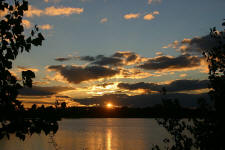

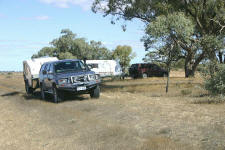

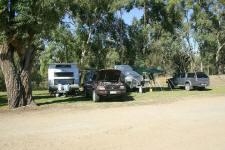
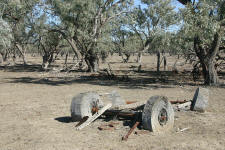



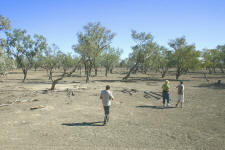

|